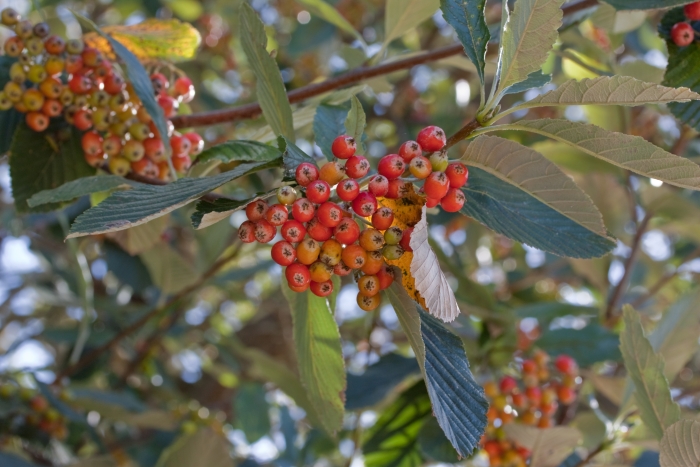Whitebeam
(Sorbus aria)
Whitebeam (Sorbus aria)
/
/

Julie Anne Workman
CC BY-SA 3.0
Image By:
Julie Anne Workman
Recorded By:
Copyright:
CC BY-SA 3.0
Copyright Notice:
Photo by: Julie Anne Workman | License Type: CC BY-SA 3.0 | License URL: https://creativecommons.org/licenses/by-sa/3.0 | Uploader: Julia W | Publisher: Wikipedia Commons |


























Estimated Native Range
Summary
Sorbus aria, commonly known as Whitebeam, is a deciduous tree native to a variety of habitats including woodland edges, limestone pavements, and cliffs in Europe and Western Asia. It typically grows to a height of 20-30 feet (6-9 meters) and a width of 15-20 feet (5-6 meters). The Whitebeam is notable for its simple, oval leaves that are green on top with a distinctive white, felt-like underside, giving the tree its common name. It produces clusters of cream-colored flowers in late spring that are moderately showy, followed by red or orange berries in the fall that are popular with birds.
Whitebeam trees are valued for their compact size, making them suitable for urban and residential planting where space is limited. They are also appreciated for their attractive foliage, which provides visual interest throughout the growing season, and their fruit, which supports local wildlife. Whitebeam trees are relatively low-maintenance, requiring minimal pruning and care once established. They are adaptable to a range of soil types, provided the soil is well-drained, and they can tolerate both full sun and partial shade. While generally disease-resistant, they can be susceptible to fireblight and leaf scorch in stressful conditions. There are several cultivars available, such as ’Lutescens’ with yellowish leaves and ’Majestica’ with larger leaves and fruits, which offer additional ornamental qualities for gardeners.CC BY-SA 4.0
Whitebeam trees are valued for their compact size, making them suitable for urban and residential planting where space is limited. They are also appreciated for their attractive foliage, which provides visual interest throughout the growing season, and their fruit, which supports local wildlife. Whitebeam trees are relatively low-maintenance, requiring minimal pruning and care once established. They are adaptable to a range of soil types, provided the soil is well-drained, and they can tolerate both full sun and partial shade. While generally disease-resistant, they can be susceptible to fireblight and leaf scorch in stressful conditions. There are several cultivars available, such as ’Lutescens’ with yellowish leaves and ’Majestica’ with larger leaves and fruits, which offer additional ornamental qualities for gardeners.CC BY-SA 4.0
Plant Description
- Plant Type: Tree
- Height: 20-30 feet
- Width: 15-20 feet
- Growth Rate: Moderate
- Flower Color: Cream, White
- Flowering Season: Spring
- Leaf Retention: Deciduous
Growth Requirements
- Sun: Full Sun
- Water: Medium
- Drainage: Fast, Medium, Slow
Common Uses
Bank Stabilization, Bee Garden, Bird Garden, Border Plant, Butterfly Garden, Edible*Disclaimer: Easyscape's listed plant edibility is for informational use. Always verify the safety and proper identification of any plant before consumption., Low Maintenance, Showy Flowers, Street Planting
Natural Habitat
Native to woodland edges, limestone pavements, and cliffs in Europe and Western Asia
Other Names
Common Names:
Scientific Names: Sorbus aria , Aria alpina , Aria edulis , Sorbus aria subsp. aria , Pyrus aria , Aria nivea , Crataegus aria , Sorbus arioides , Sorbus aria var. incisa , Sorbus aria var. longifolia
GBIF Accepted Name: Aria edulis (Willd.) M.Roem.